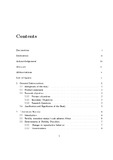| dc.description.abstract | Fertility transition has been identi ed to be a¤ected by numerous factors. This research
aimed at investigation of the most e¤ective factors a¤ecting fertility transition in Kenya.
These factors were rstly extracted from literature, convened into demographic features,
social economic features, social cultural features, reproductive features and moderniza-
tion features. All these factors had 23 parameters identi ed for this study. Principal
component analysis (PCA) was utilized using 23 parameters; Principal component analy-
sis conveyed religion, region, education and marital status as the factors. PC scores were
calculated for every point. The identi ed principal components were utilized as forecast-
ers the multiple regression model with the fertility level as the response variable. The
four components were found to be a¤ecting fertility transition di¤erently. It was found
that fertility is a¤ected positively by factors region and marital status and negatively by
factors religion and education. These four factors can be considered in the planning policy
in Kenya. | en_US |



